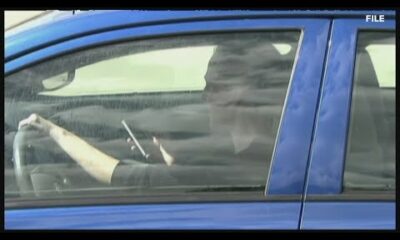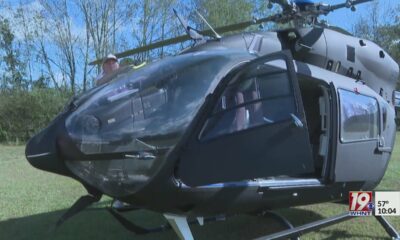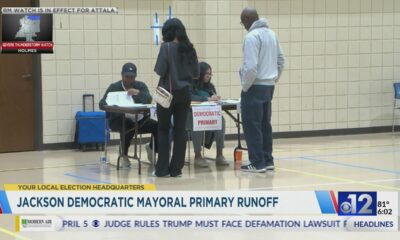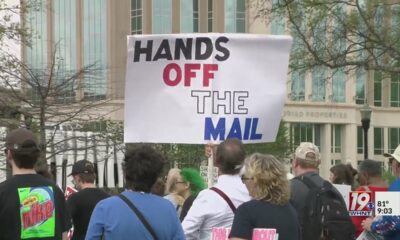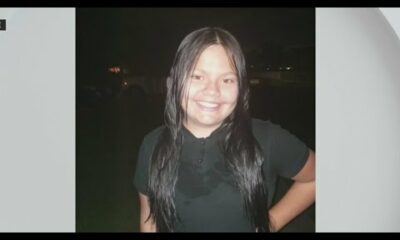News from the South - Kentucky News Feed
More snow for Monday
SUMMARY: Today, a winter storm warning remains in effect until 7 PM, bringing additional snow and ice to the WLKY region, with temperatures around 29°F feeling like 18°F due to wind chill. Residents are advised to stay indoors, as driving conditions are hazardous with accumulated snow and potential power outages from downed trees and lines. Throughout the day, expect snowfall mostly across southern Indiana and the Ohio River, with accumulations of 1 to 3 inches. Temperatures will remain below freezing with lows in the teens and highs only reaching the upper 20s. Frigid weather persists into Wednesday and Thursday.

More snow for Monday
Subscribe to WLKY on YouTube now for more: http://bit.ly/1e5KyMO
Get more Louisville news: http://www.wlky.com
Like us: http://www.facebook.com/wlkynews
Follow us: http://twitter.com/WLKY
Instagram: https://www.instagram.com/wlky/
News from the South - Kentucky News Feed
WLKY Investigates: Judge calls decision not to renew Baxter 942’s liquor license ‘unreasonable’
SUMMARY: Baxter’s 942 bar, closed for five months after its liquor license was not renewed, could soon reopen following a judge’s recommendation to restore the license. The closure followed community complaints about noise and violence, including shootings near the bar, although not on its property. The judge ruled that denying the license based on third-party criminal activity was unreasonable. Despite the ruling, local neighbors, especially those at a nearby dog park, oppose the bar’s reopening. Louisville Metro ABC has 15 days to file for an exception, with the final decision resting with a three-judge panel.

WLKY Investigates: Judge calls decision not to renew Baxter 942’s liquor license ‘unreasonable’
Subscribe to WLKY on YouTube now for more: http://bit.ly/1e5KyMO
Get more Louisville news: http://www.wlky.com
Like us: http://www.facebook.com/wlkynews
Follow us: http://twitter.com/WLKY
Instagram: https://www.instagram.com/wlky/
News from the South - Kentucky News Feed
Beshear updates flood recovery: Death toll rises to 6, submitting FEMA request Friday
SUMMARY: Governor Andy Beshear provided an update on Kentucky’s flood recovery, with the death toll rising to six. Over 70 counties have declared states of emergency, and flooding continues downstream. Beshear expressed concern that disaster funding may run out soon, but no special session is planned yet. FEMA assistance will be requested on Friday, initially covering 10-12 counties. Affected families could receive up to $42,000 in aid, with $750 in initial help. The governor urged residents to document all damage carefully to aid their applications. Recovery centers’ locations are being discussed with FEMA as the disaster response continues.

Gov. Andy Beshear said the state is not at a point to require a special session to respond to natural disasters “yet.”
Subscribe to FOX 56 News on YouTube: https://www.youtube.com/c/FOX56News/?sub_confirmation=1
Stay informed about central Kentucky news, weather, and sports! Follow FOX 56 on our website and social channels:
https://www.FOX56News.com
https://www.youtube.com/c/FOX56News
https://www.facebook.com/FOX56News
https://twitter.com/FOX56News
https://www.instagram.com/FOX56News
https://www.linkedin.com/company/FOX56News
News from the South - Kentucky News Feed
Goodwill Industries of Kentucky provides vouchers for those impacted by flooding
SUMMARY: Goodwill Industries of Kentucky is providing assistance to those affected by recent flooding in locations such as Bowling Green, Corbin, and Louisville. The organization is offering vouchers to support impacted individuals, available at Goodwill Opportunity Centers in several cities, including Bowling Green, Elizabethtown, and Paducah. For areas without a center, vouchers can be accessed through Community Action Kentucky. Each center lists a specific address and phone number for obtaining these vouchers, ensuring that help reaches those in need across the affected regions.
The post Goodwill Industries of Kentucky provides vouchers for those impacted by flooding appeared first on www.wnky.com
-

 The Center Square6 days ago
The Center Square6 days agoCA fails audit of federal programs, 66% of COVID unemployment benefits in question | California
-

 News from the South - Alabama News Feed5 days ago
News from the South - Alabama News Feed5 days ago‘Hands Off!’ Protest Held in Huntsville Saturday | April 5, 2025 | News 19 @ 9 P.M.
-

 News from the South - Florida News Feed7 days ago
News from the South - Florida News Feed7 days agoFlorida student accused of punching deputy in the face
-

 News from the South - North Carolina News Feed7 days ago
News from the South - North Carolina News Feed7 days agoState appeals court finds merit in protests of nation’s last unsettled election | North Carolina
-

 News from the South - Florida News Feed6 days ago
News from the South - Florida News Feed6 days agoSouth Florida dad shares update on daughter severely burned in Molotov cocktail attack
-

 News from the South - Alabama News Feed6 days ago
News from the South - Alabama News Feed6 days agoFour people rescued, two taken to hospital after Birmingham apartment fire
-

 Mississippi Today7 days ago
Mississippi Today7 days agoMeet Willye B. White: A Mississippian we should all celebrate
-

 News from the South - North Carolina News Feed5 days ago
News from the South - North Carolina News Feed5 days agoProposal: American military base retailers would exclude 4 hostile nations | North Carolina

